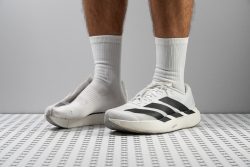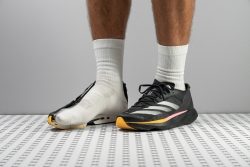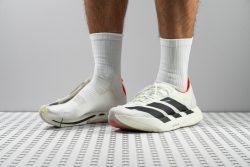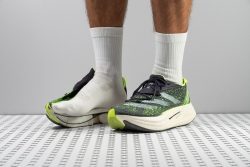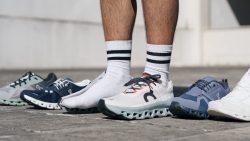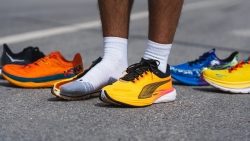7 Best Adidas Running Shoes in 2025
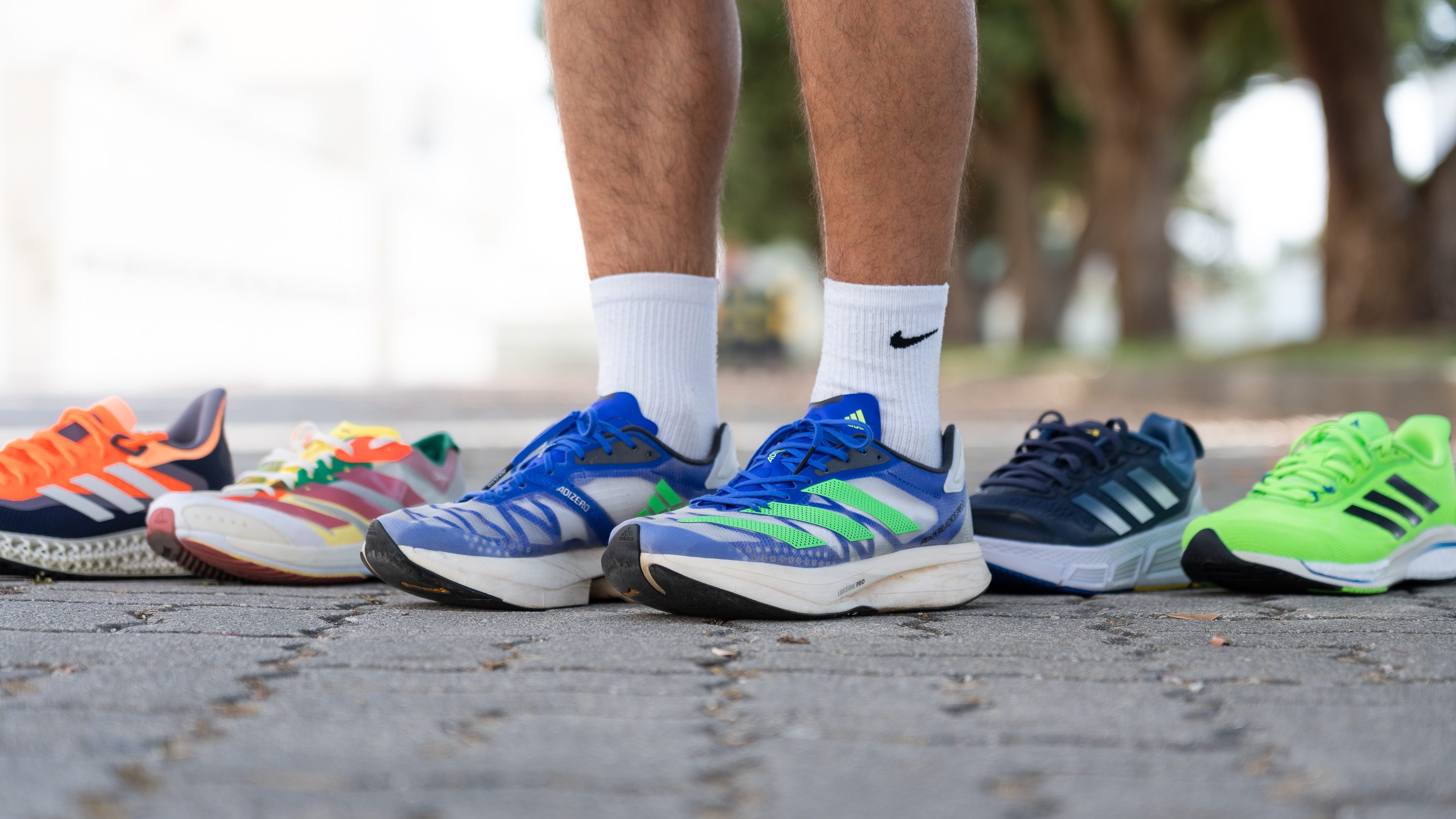
We buy shoes ourselves. We earn commissions when you buy through us, at no extra cost. Why trust us
Adidas is one of the top brands in the athletic gear scene and continues to be a popular choice for running shoes.
To help you navigate the brand’s extensive selection of running shoes, we have selected the best models in different categories. All the Adidas shoes we reviewed had gone through our lab and wear tests before we made them our best picks.
Do you want a stylish trainer to double for jogging and a fashion statement? Are you planning to hit a race and need a speedy horse? Or are you headed for the trails to crush the rocks and mud? We've got you covered.
How we test Adidas running shoes
We are a team of running shoe fanatics with an independent shoe-testing lab. After running a minimum of 30 miles in each pair, we spend an additional 9-13 hours to test the shoe in the lab and publish the written review along with all the lab data.
- Our inspection includes every imaginable aspect, from shoe flexibility and midsole softness tests to examining the upper under the microscope and destroying the upper with our Dremel.
- We even built a custom smoke machine to demonstrate each shoe’s breathability levels.
- We receive no free shoes from Adidas and purchase them at retail with our own funds. This applies to all shoes we test, not just Adidas, of course.
Best Adidas running shoes overall
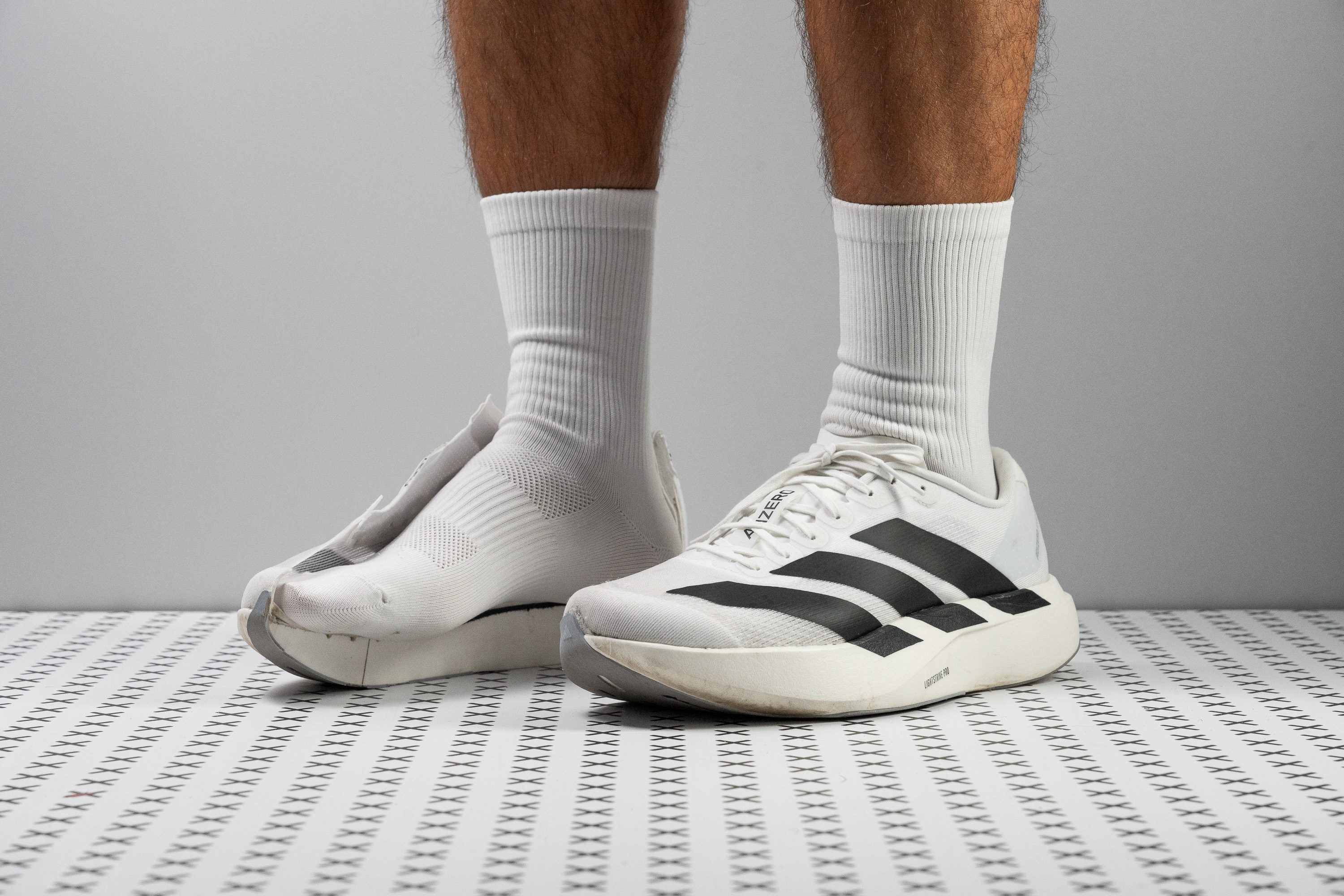






























































What makes it the best?
The Adidas Adizero EVO SL offers unbelievable propulsion and grip for its $150 price. Our lab tests show it features premium features that explain its performance, like the 100% Lightstrike Pro midsole and the Continental rubber. It has a light and easygoing nature that makes it suitable across various paces and distances, making it our top Adidas running shoe.
The midsole felt well-cushioned and highly responsive. Our durometer confirms it’s a balanced 21.3 HA that performs magically on both fast and aerobic days. Even during LSD days, impact protection was delivered by the 36.1/28.1 mm stack.
For its height, the Adizero EVO SL is amazingly lightweight at 7.9 oz (223g), close to other racers. Its plateless design boosts comfort and versatility, as the midsole moves freely with our feet. Our bend test validates it’s 31.9% more flexible than average.
The outsole features the grippy Continental rubber in the forefoot, evidenced by its low 59.5 HC durometer rating, and two Clear Rubber patches in the heel for better durability. True enough, despite its soft 57.1 HC rubber, our Dremel only damaged the heel by 0.6 mm vs. the 1.0 mm average. Because of its razor-thin 1.6 mm outsole, we enjoyed the responsive midsole more vividly.
However, its streamlined design makes it less supportive. We recommend even those with mild stability needs to check other options.
Pros
- 100% Lightstrike Pro superfoam
- Exceptional value-to-performance ratio
- Low weight
- Ultra-breathable upper
- Unmatched versatility
- Agile and fun ride
- Superior Continental rubber
- Handles short and long runs with ease
- Striking Evo 1-inspired aesthetics
Cons
- Poor-quality laces
- Short, non-gusseted tongue
- Toebox durability
Best Adidas daily running shoes
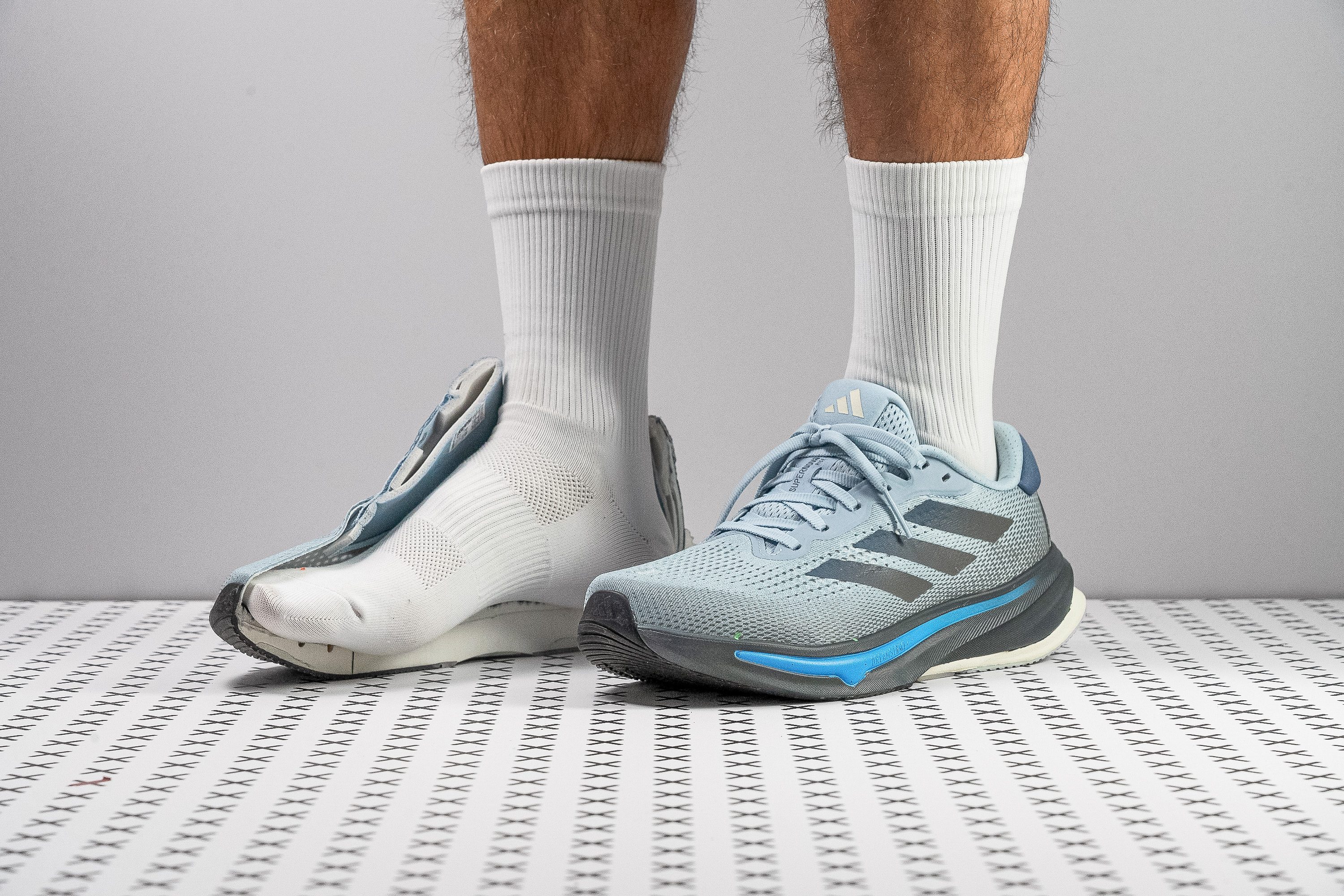





















































What makes it the best?
In the Supernova Rise, comfort takes center stage, supporting our feet with ample cushioning and ventilation. Plus, it delivers such a stable ride in both our lab tests and runs, earning the top spot as Adidas' best daily trainer.
Mile after mile, the Dreamstrike+ cushioning consistently delivers a balanced ride. While not the tallest, its 32.5 mm heel dampens impact and gives comfort for long runs. Our durometer reveals a reading of 20.1 HA, around the average, which feels soft yet not overly plush. The platform is protected by Support Rods underneath, to further enhance stability and durability. Together with the undeniable heel bevel and balanced foam, it was easy for us to find our footing and avoid wobbles.
The upper’s design includes abundant ventilation holes, which keep our feet fresh and free from hotspots. Serving their purpose, the shoe earned a remarkable 4/5 rating in our breathability tests, perfect for all-day wear.
However, the forefoot rises to a modest 22.8 mm, which may feel lacking and too steep for mid-to-forefoot strikers, especially during longer distances. Those who prefer a more balanced ride should explore other trainers.
Pros
- Stable ride
- Ideal for heel strikers
- Smooth heel bevel
- Plush, cozy upper
- Breathable and durable
- Finally new PEBA foam
- Excellent value at $140
- Toebox offers exceptional width and height
Cons
- No Continental rubber
- Tongue lacks gusset
- Limited energy return
Best Adidas shoes for tempo workouts
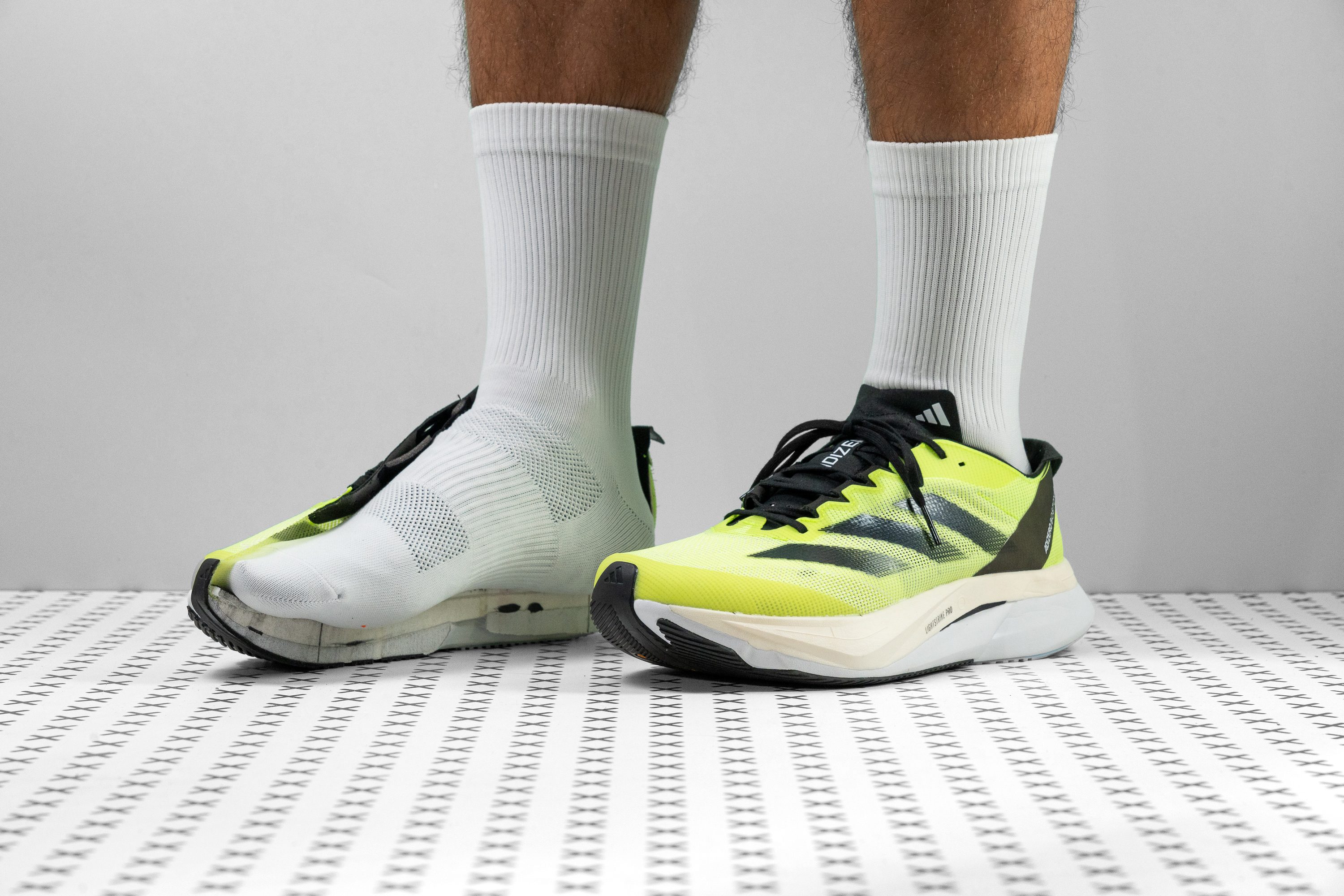












































What makes it the best?
The Adizero Boston 12 is a towering speed demon, boasting a fresh and mighty ride to take on daunting reps with ease. As an entry-level supershoe, this is Adidas’ best kick for speed training.
At its 12th iteration, this Boston displays now fiber-glass Energyrods, the masterminds behind its powerful yet flexible feel—11.3% more flexible than average to be more precise. Bounce is delivered in spades here, with the premium layer of Lightsrike Pro taking the credit for it. Our durometer ranked this foam as 22.9% softer than average, and it’s the exceptional energy return that propels the Boston 12 into the top tier of speed trainers.
Not only underfoot is a speedster created; the Boston’s upper is equally up to the task. As one does, we pumped smoke into the shoe to assess its airflow. Through the tongue, sides, and toebox, the smoke ushed out with such ease that we awarded the Boston 12 a perfect 5/5 score for breathability.
During our usual stress test, four seconds of spinning 3.2N at 10K RPM were enough to completely tear the upper apart. In durability matters, the Boston’s toebox received the weakest possible score.
Pros
- Lightstrike 2.0 brings a remarkable upgrade
- Delivers a fun ride
- Lighter than versions 10 and 11
- Handles both slow and fast paces with ease
- Wide toebox
- Durable and grippy Continental outsole
- Even more Lightstrike Pro superfoam
- Improved stability due to a broader base
- Fantastic for midfoot-to-forefoot strikers
Cons
- Upper durability falls short
- Tongue and heel could benefit from extra padding
- Heel strikers might prefer v11
Best Adidas running shoes for 5K/10K races


















































What makes it the best?
In our runs, the Adidas Adizero Takumi Sen 10 exhibited pure racer energy with its light build, insanely responsive midsole, and extra grippy Continental outsole. It’s designed around saving weight, satisfying our goal to shave off seconds from our PBs. Solid lab results make it our top Adidas shoe for 5-10K races.
TS10 feels undeniably featherweight and our scales confirm a mere 7.1 oz (200g), 32.0% lighter than the average Adidas shoe in our lab. For shorter races, every gram counts and TS10 ensures we’re unburdened. Adding to its lightness is the seamless airflow, which our smoke test confirmed with a perfect breathability rating.
We’re reminded of TS10’s presence on foot through its massive energy return, propelling us forward effortlessly. Diving into the midsole, we discovered Energy Rods 2.0 nestled between two Lightstrike Pro foam layers—the top a plush 13.4 HA for comfort and the bottom a firmer 20.4 HA for stability. We found that the fiberglass rods aren’t as stiff as carbon-plated shoes.
Underfoot, the Continental rubber is aggressively grippy with a durometer reading 35.3% softer than average. We had no issues at all with traction on any surface, yet the soft and merely 1.8 mm thin rubber will disappoint runners who prioritize durability. Those who want long-lasting shoes should invest elsewhere.
Pros
- Lightweight
- Awesome for 5K/10K races
- Responsive Lightstrike Pro midsole
- Breathable engineered mesh
- Loves to go fast
- Awesome for track workouts
- Continental rubber
- Amazing at taking corners
- Recycled materials in the upper
Cons
- Not for heel strikers
- Durability concerns
- Extremely cramped fit
Best comfortable Adidas running shoes
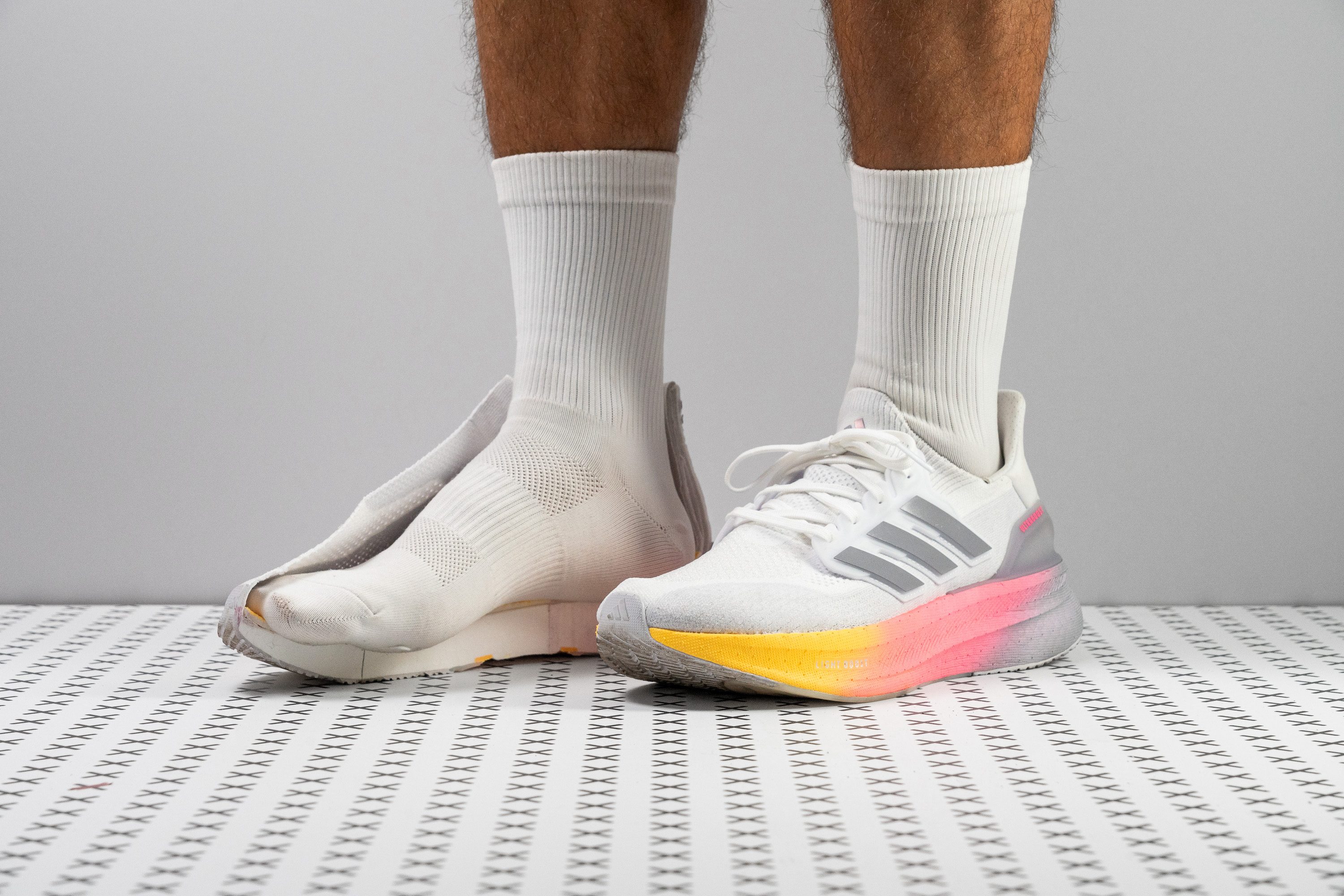
















































What makes it the best?
Our lab numbers show what we experienced in our runs: the Ultraboost 5 provides the best comfort among Adidas running shoes. From its gentle foam, breathable build, and spacious fit, comfort is at the forefront and we found ourselves reaching for this pair for everyday wear. Plus, it includes the highly-rated Continental outsole!
The Light Boost foam felt pleasantly plush, confirmed by our durometer reading of 17.0 HA. Besides the relief we received underfoot, Ultraboost 5 feels easy to wear because of its fluid midsole. Our bend test proves it’s 34.6% more flexible than the average running shoe.
The soft and stretchy Primeknit upper embraces the top of our foot, which adds to its spacious feel. Checking the toebox reveals it’s wider than average, notably in the 81.8 mm big toe area, accommodating even those with broad feet. The seamless airflow boosts comfort, evidenced by its perfect breathability score in our smoke test.
Underfoot, the Continental outsole displays reliable performance in terms of durability and grip. Despite measuring a soft 69.1 HC, it proved its resistance to wear in our Dremel test by showing an insignificant 0.8 mm dent.
Unfortunately, the midsole lacks responsiveness and we find this shoe suits easy paces best.
Pros
- Enhanced midsole cushioning
- Roomy, comfortable knit upper
- Suitable for daily wear
- Excellent durability
- Optimized for heel strikers
- Superior Continental outsole
- More cushioned than ever before
- Can handle forefoot strikers
- Great for summer
Cons
- Could still be lighter
- Not suitable for fast paces
- Potential for heel slippage
Best Adidas running shoes for race day
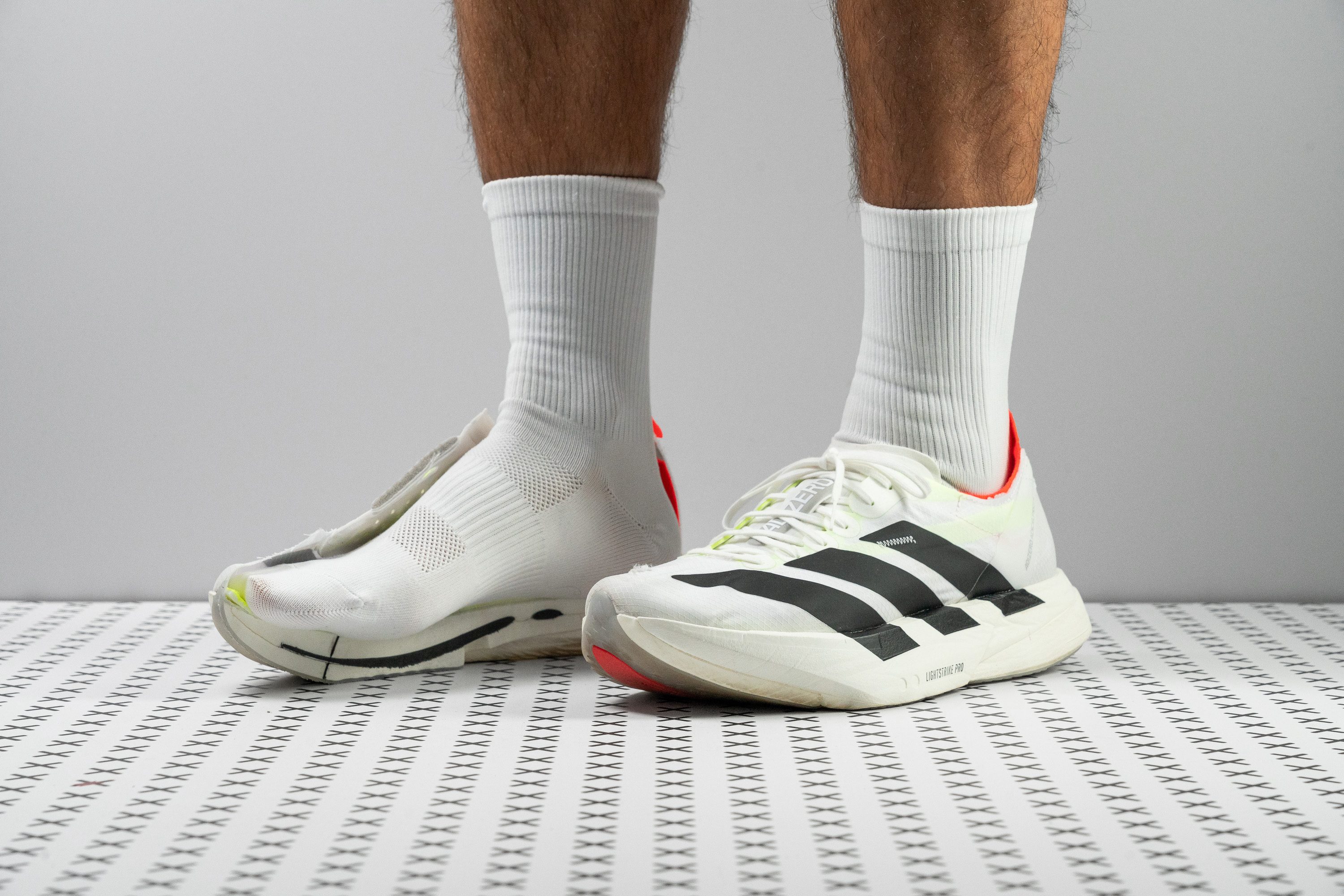

























































What makes it the best?
We experienced the best of both worlds in the Adizero Adios Pro 4! It ticks the boxes of a supershoe with its lightning speed, comfy ride, and airy nature, making it our ultimate Adidas running race shoe. While its counterparts tend to be stiff, it's the exact opposite because of its Energy Rods 2.0.
It blends comfort and speed in harmony through its stack and perfect amount of rigidity. The cushion feels delightful, reaching a massive 36.6/28.5 mm. Our durometer shows it’s amazingly 47.9% softer than average! Every stride feels powerful with its insane energy return thanks to the Energy Rods 2.0 that mimics our foot anatomy, providing resistance without being too stiff. Our flex test validates it’s only 13.1% more resistant than average while other racers fare much higher.
Exceeding the standard racer, AP4 has a wider-than-average landing base in the forefoot—an additional 4.7 mm, promoting stable landings for forefoot and midfoot strikers. Even when cornering at high speeds, we remain steady and in control with the help of the super adhesive Continental rubber patch underneath our forefoot.
AP4 helped us fly to the finish line with less fatigue with its mere 7.1 oz (200g) weight, 24.8% lighter than average. However, the midsole loses its magic after 100 miles because of its softer composition. If longevity is a priority, the previous version can deliver that.
Pros
- Softer, bouncier Lightstrike Pro foam
- Maintains the same price
- No more heel slippage
- Versatile from 5K to marathon distances
- Durable outsole with outstanding grip
- Fantastic for midfoot and forefoot strikers
- Improved for faster runners
- Comfortable, gusseted tongue
- Lighter than Adios Pro 3
Cons
- Unstable for every heel striker
- Narrow, tapered toebox
- Upper lacks breathability
- Midsole loses bounce quicker than AP3
Best Adidas super shoes
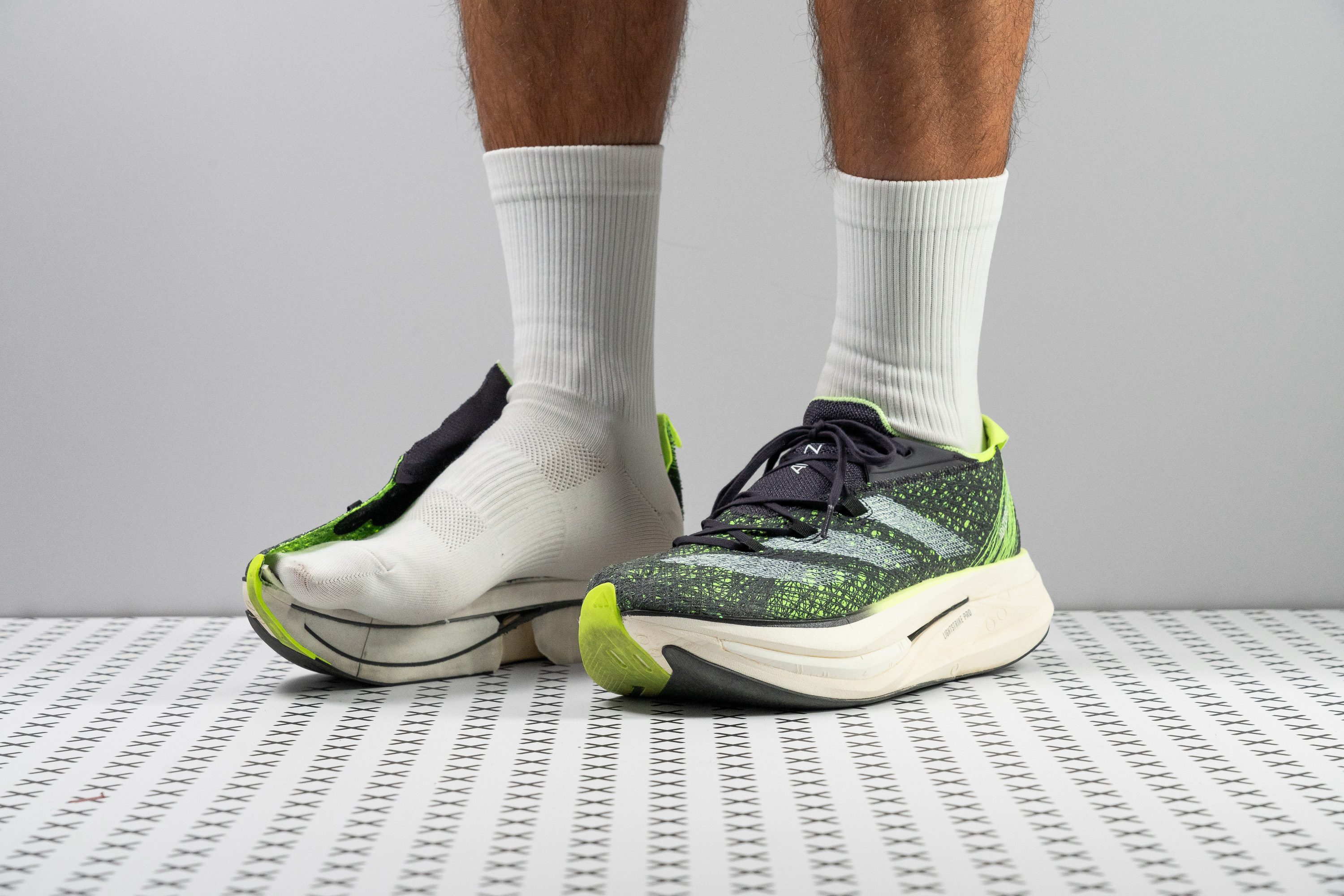

























































What makes it the best?
The Adidas Adizero Prime X 2 Strung pushes the boundaries with our pace and its construction. Delving deeper into the lab was a true pleasure as we discovered the makings of this masterpiece—featuring a colossal stack height with four distinct densities, dual carbon plates, and a finely constructed outsole. Without a doubt, it’s Adidas’ prime super shoe.
On foot, we knew we had limitless cushioning beneath us that consisted of unique materials with its one-of-a-kind ride. Our caliper confirms a massive, race-illegal 45.7/36.9 mm, the tallest we’ve ever seen in the lab! We had zero ground feel and infinite responsiveness. The midsole features four distinct foams: a dense 24.3 HA for stability, a soft 14.9 HA, and two plush foams at 11.5 HA and 11.0 HA, all working together for exceptional comfort and energy return.
Prime X breaks the standard with two carbon plates: a flat piece for stability and a curved one for higher power output. The ride feels highly springy yet also amazingly stable. Further enhancing solid surefootedness is the grippy 60.4 HC outsole. Our jaws dropped again when it resisted our Dremel with only an insignificant 0.3 mm, truly a standout in our lab!
While Prime X adds so many unique features, it also adds weight. At 10.8 oz (305g), it’s too heavy for racing.
Pros
- Amazing Strung upper
- Impressive durability
- Rule-breaker cushioning
- Integrated dual carbon plates
- Exceptional Continental outsole
- Wonderful for long distance training
- Stability exceeds expectations
- Superior build quality
- Screams innovation
Cons
- Simply too heavy
- Exorbitantly priced at $300
- Less exhilarating than v1
Comfort: How soft are Adidas running shoes?
The softness of the midsole depends on the type of foam used. And softness is usually the #1 thing correlated with comfort. In the next section, we cover most common Adidas foams and their features. But, if you care about softness only, here’s our data.
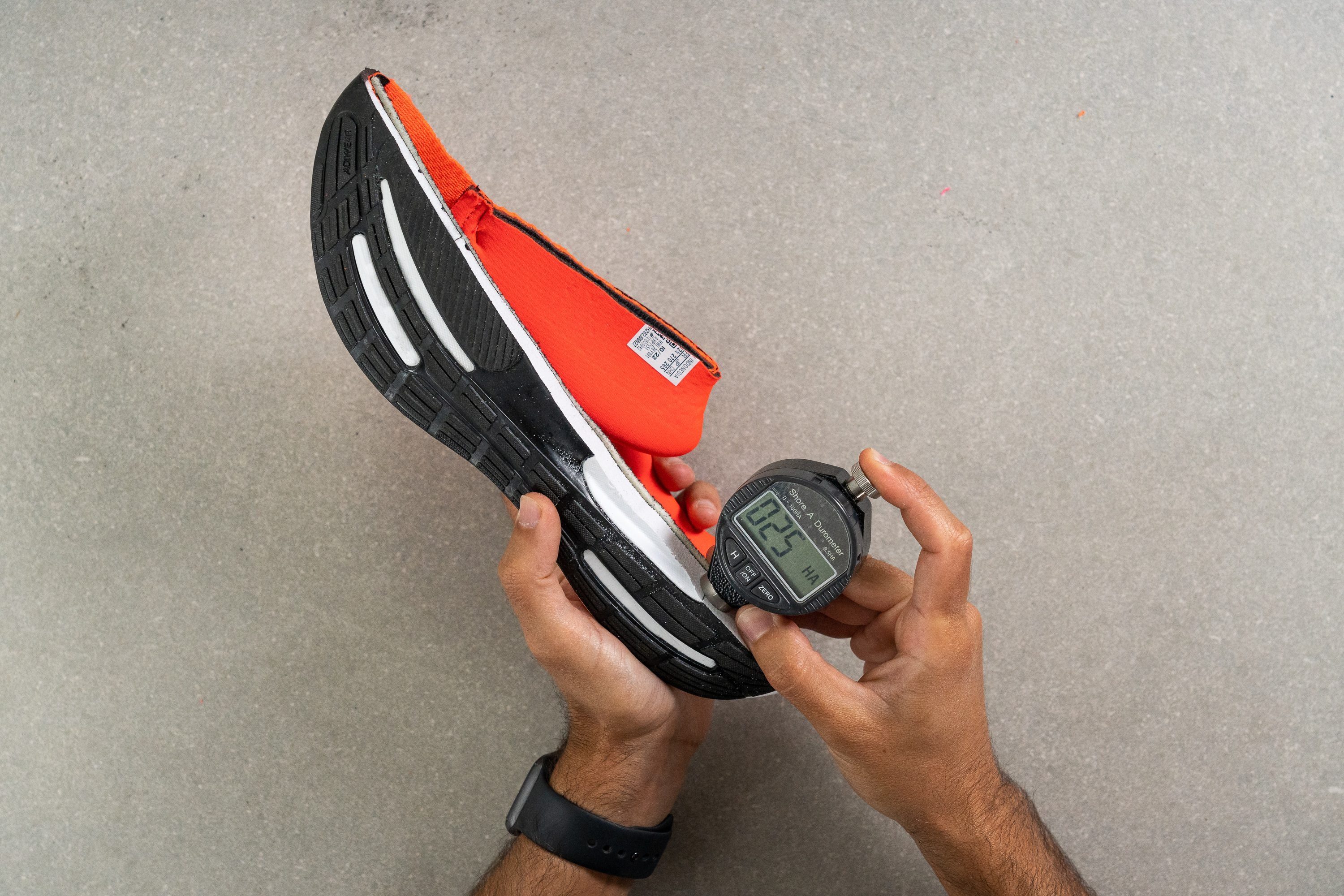
Lower numbers on the durometer indicate a softer foam, while firmer foams score higher.
Adidas foams explained
In the world of foams, we have standard foams and premium foams. Standard foams are cheaper, more durable and more stable than the premium foams. However, premium foams are way more responsive, leg-saving, good for winter as they do not firm up or stiffen up as much as standard foams.
As we’ve written in our Ultimate guide on running shoe foams, Adidas makes 4 popular standard foams and 1 premium foam. See their features below:
|
Foam |
Type |
Best thing |
Drawback |
|
Boost (TPU) |
Standard |
Comfortable |
Heavy |
|
Light Boost (TPU) |
Standard |
Weight |
Boring |
|
Lightstrike (EVA/TPU) |
Standard |
Stability |
Too firm |
|
Dreamstrike+ (Bio-based PEBA) |
Standard |
Versatile |
Weight |
|
Lightstrike Pro (TPEE) |
Premium |
Super-durable all-rounder |
Break-in needed |
Boost
Made in 2013, Adidas Boost felt out of this world, given its energy return that was higher than 75%. It was so much better than the EVA-based midsoles and it allowed quite a few long-distance world records to be broken. Today it is almost outdated. It is still comfortable but heavy, which is why a) we see it in sneakers rather than in running shoes b) Adidas made a lighter version, Light Boost.
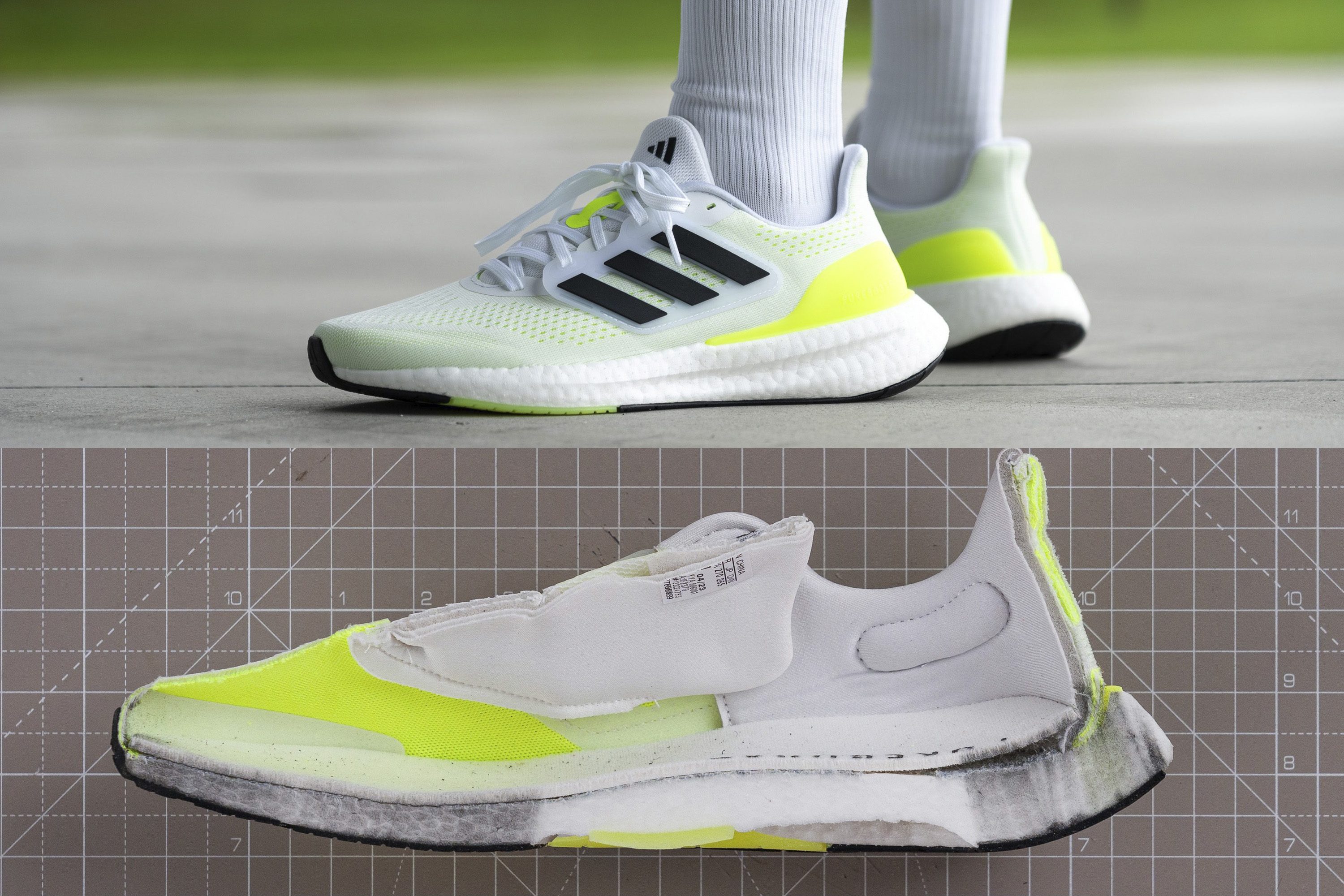
Light Boost
This foam came 10 years after the original Boost and it was worth the wait given that it weighs 30% less.

Lightstrike
Lightstrike went through some sort of a crisis, going from being fully TPU-based to EVA-based. You can find it labeled as Lightstrike (made from TPU), Lightstrike EVA, or Lightstrike 2.0 (which is also made from EVA). These 3 foams do not perform well and most runners have found them firm and definitely lacking the fun (pop).
Lightstrike usually feels like a brick and lacks responsiveness
Our field tests and lab tests have confirmed this, as we can see in the case of Adizero SL.
Dreamstrike+
Although still a standard foam, the Dreamstrike+ features 20% bio-based content and it’s slightly better than average standard foam, given that it has a reasonable energy return.
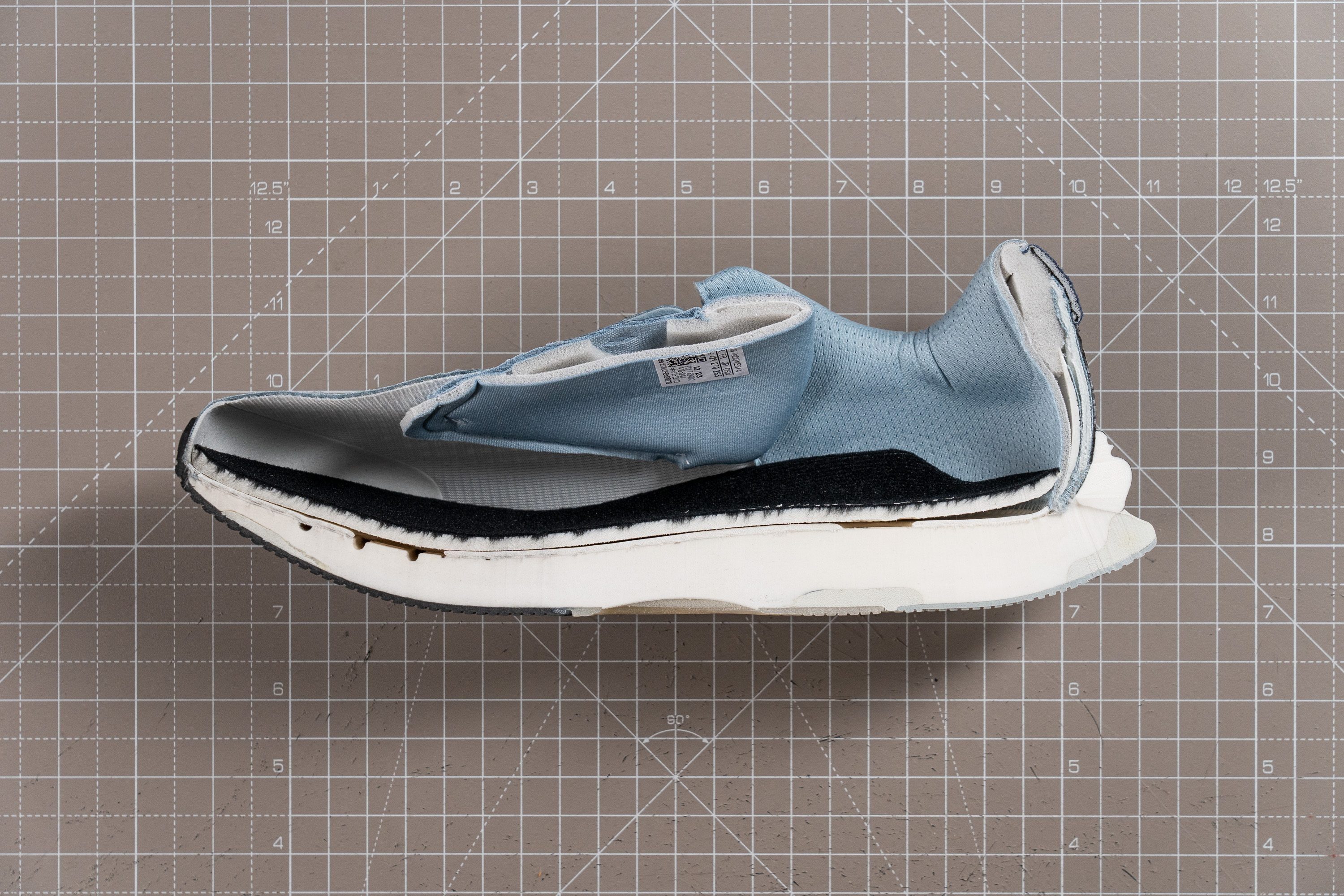
It’s made from PEBA but feels more like a TPU or supercritical EVA, given that the energy return is not that good.
Adidas Lightstrike Pro
Now this foam is just the opposite of the regular Lightstrike. It is AMAZING. We first saw this premium foam in the Adizero Adios Pro.
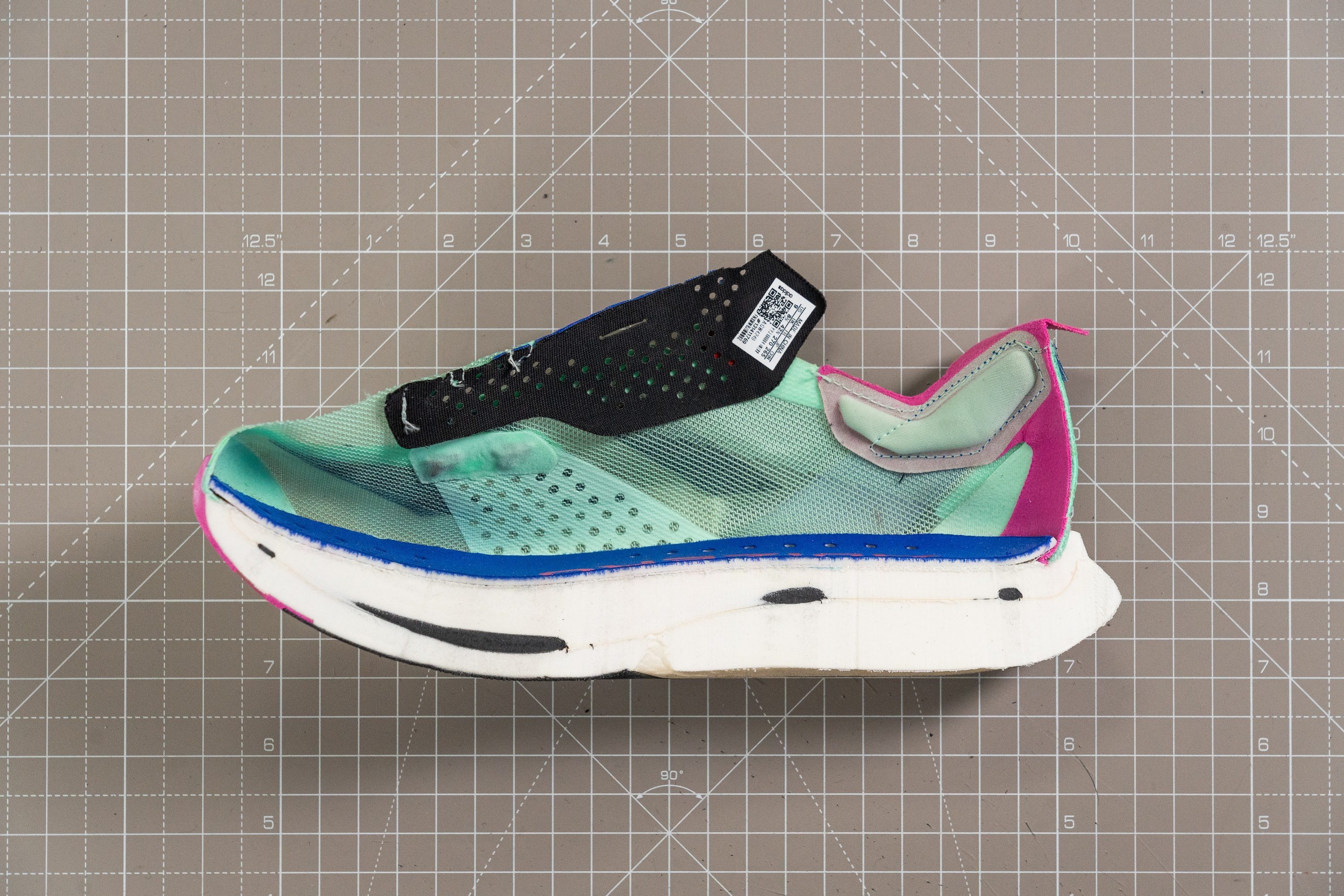
It’s made from TPEE (Thermoplastic Polyester Elastomer), which brings superb durability, the need for break-in, and a firmer ride when compared to other premium foams made from PEBA.
|
Shoes with Lightstrike Pro foam |
Most prominent features |
|
Perfect for long distances, stable |
|
|
Great responsiveness, stable at fast paces |
|
|
Superb stability, insane energy return, featherlight |
|
|
Very fast, responsive, lightweight; great for cornering |
Adidas Lightstrike Pro Evo
A variation of Lightstrike Pro is Lightstrike Pro Evo. It’s less dense and more lightweight. We saw it in the Adidas Adizero Adios Pro Evo 1 in 2023, which is actually 50g lighter than the Adios Pro 3, and that’s because the foam is made through a very expensive, supercritical process where first the foam blocks are made and then they are cut into exact shapes. This is a ground-breaking non-compression molding process.
Adidas uppers explained
The 2 most common upper materials found in running shoes are knit and mesh. We wrote extensively about all sorts of uppers in our guide Running shoe upper: how to choose the best one for your needs but will cover the basics and Adidas uppers here.
|
Knit |
Mesh |
|
|
Pros |
Comfortable, hugs the feet, stretchy, great for wider feet, smaller chance of blisters |
Lightweight, breathable, durable, water-resistant or dries quickly |
|
Cons |
Warm, gets soaked easily and takes time to dry, heavier than mesh |
Has no give (it’s not stretchy or flexible), break-in could be needed |
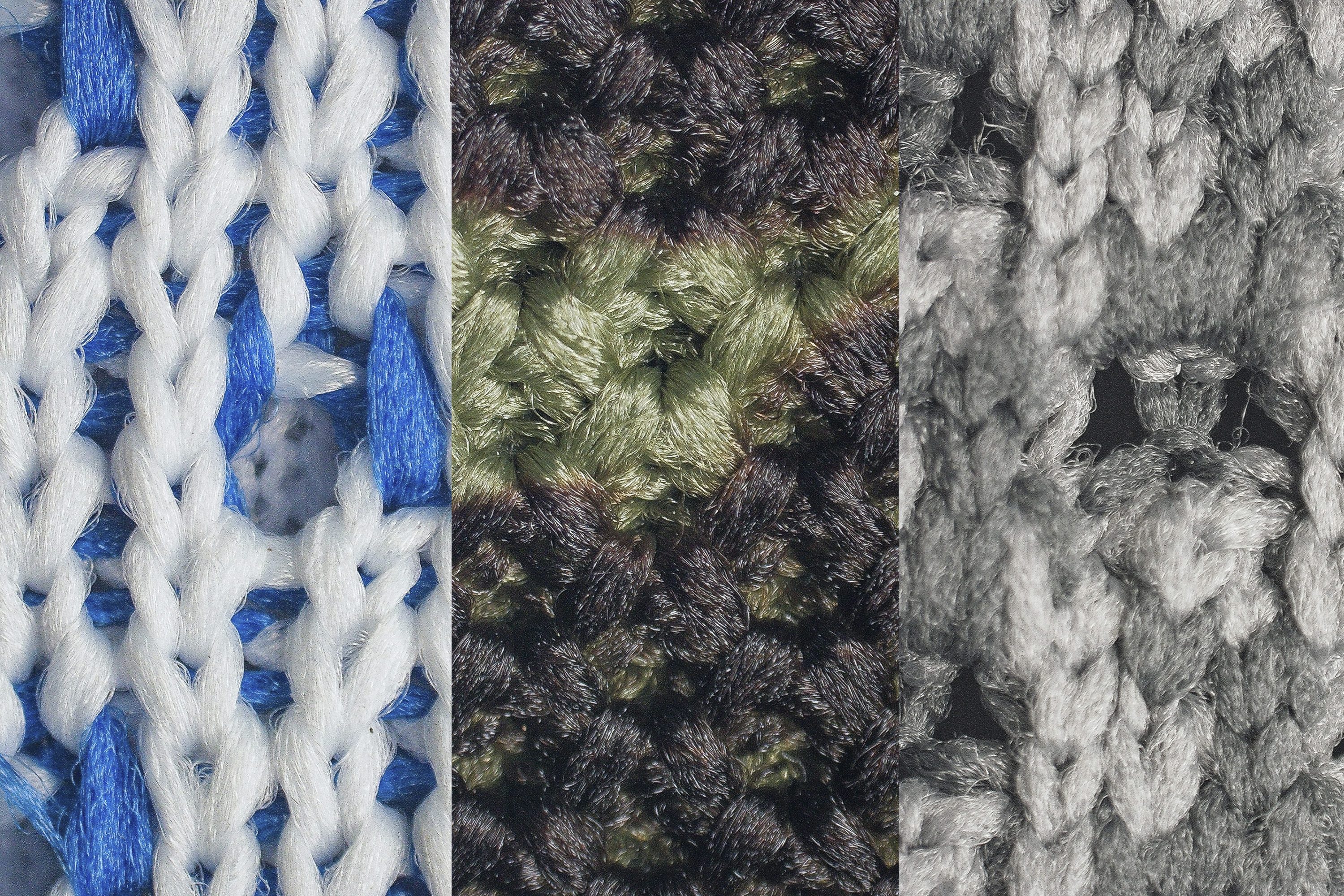

Our lab tests confirmed that knit uppers breathe worse than mesh uppers. We pump the smoke into the shoes and watch how fast it comes out and where exactly. Doing this allows us to assign a breathability score to each shoe: 1-5, where 1 is the least breathable (or the most cold-weather friendly).
The least breathable Adidas running shoes are not always knit and that’s because Adidas often doubles the mesh or combines it with other materials. This is clearly visible under the microscope in case you want to investigate it further (and look at our closeup pics).
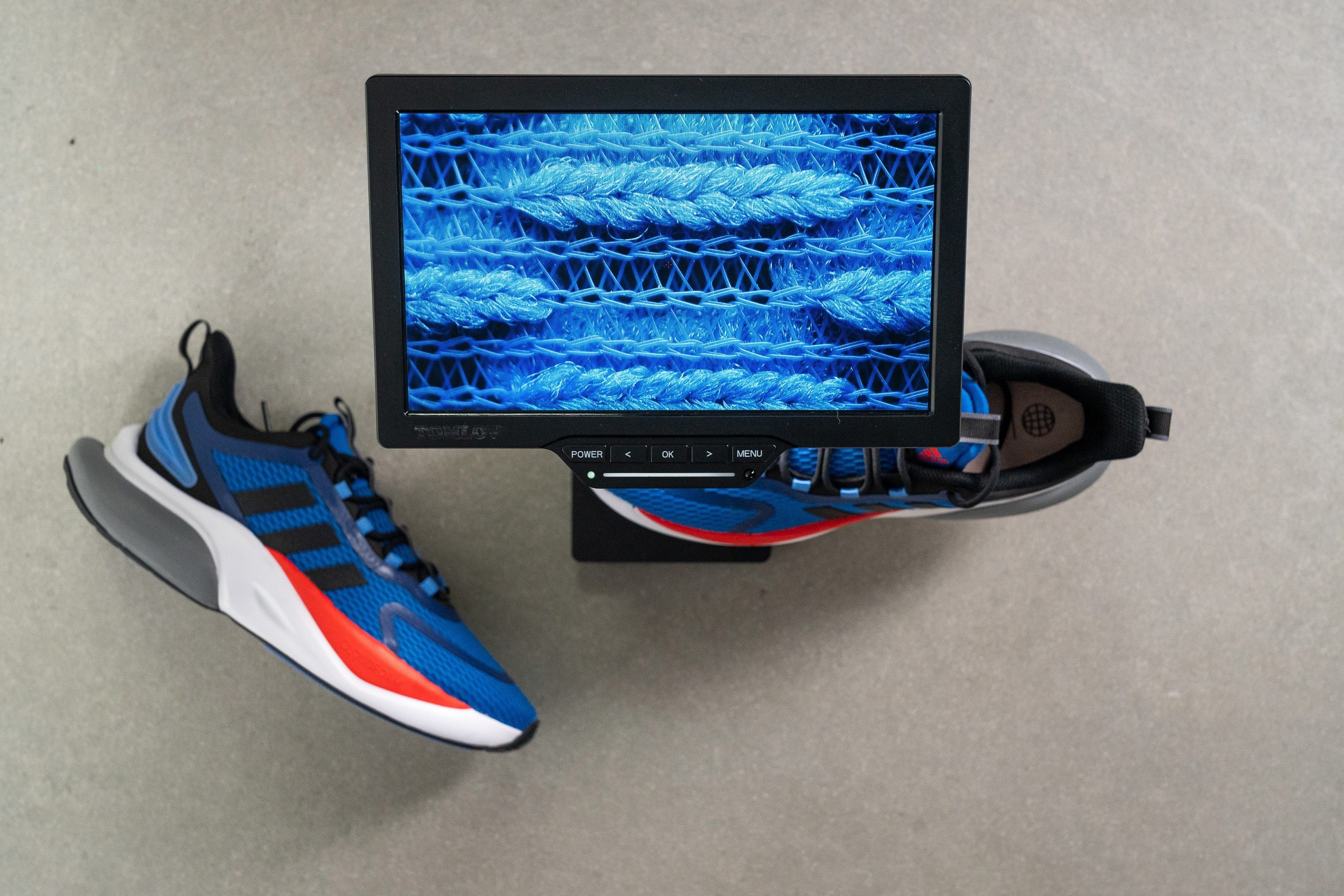
As shown above, we also look at the upper under the microscope to examine and understand all the details related to breathability. It’s easy to see how knit uppers have looser and softer structures, while mesh uppers have tighter threads with (sometimes quite large) ventilation holes.
Strung: mesh upper
There’s a Strung robot that looks like an octopus, each leg holding a different material or tool and it makes the Strung upper.
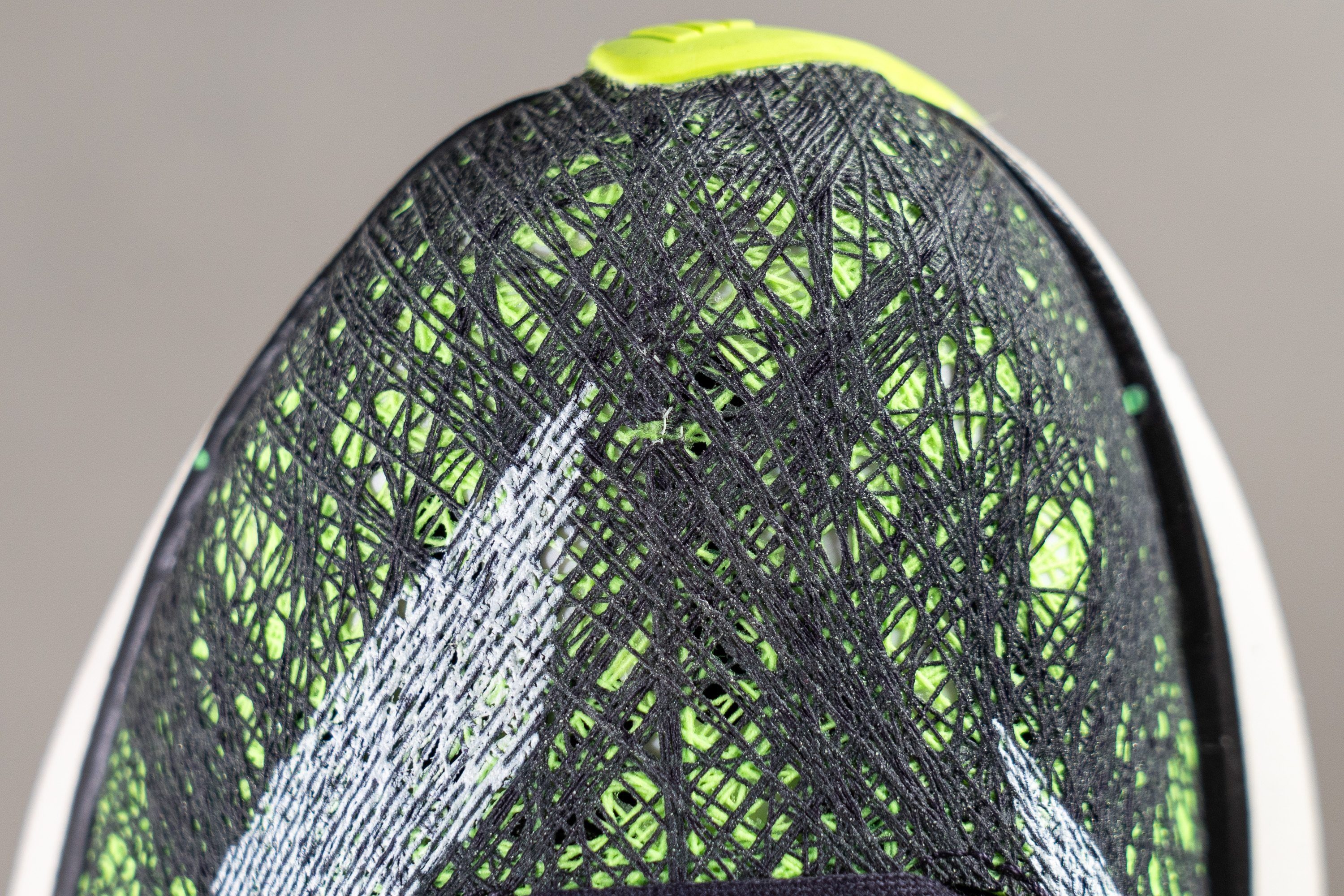
The robot can be given athletes’ feet data for a precise fit and there’s minimal excess material. Robot makes multiple threads in different directions until it achieves what Adidas calls a cocoon. It’s lightweight, breathable, and very comfortable.
Primeknit: knit upper
What makes this knit upper stick from the rest is the fact that it’s made as a whole piece. It’s not different pieces of material stitched together.
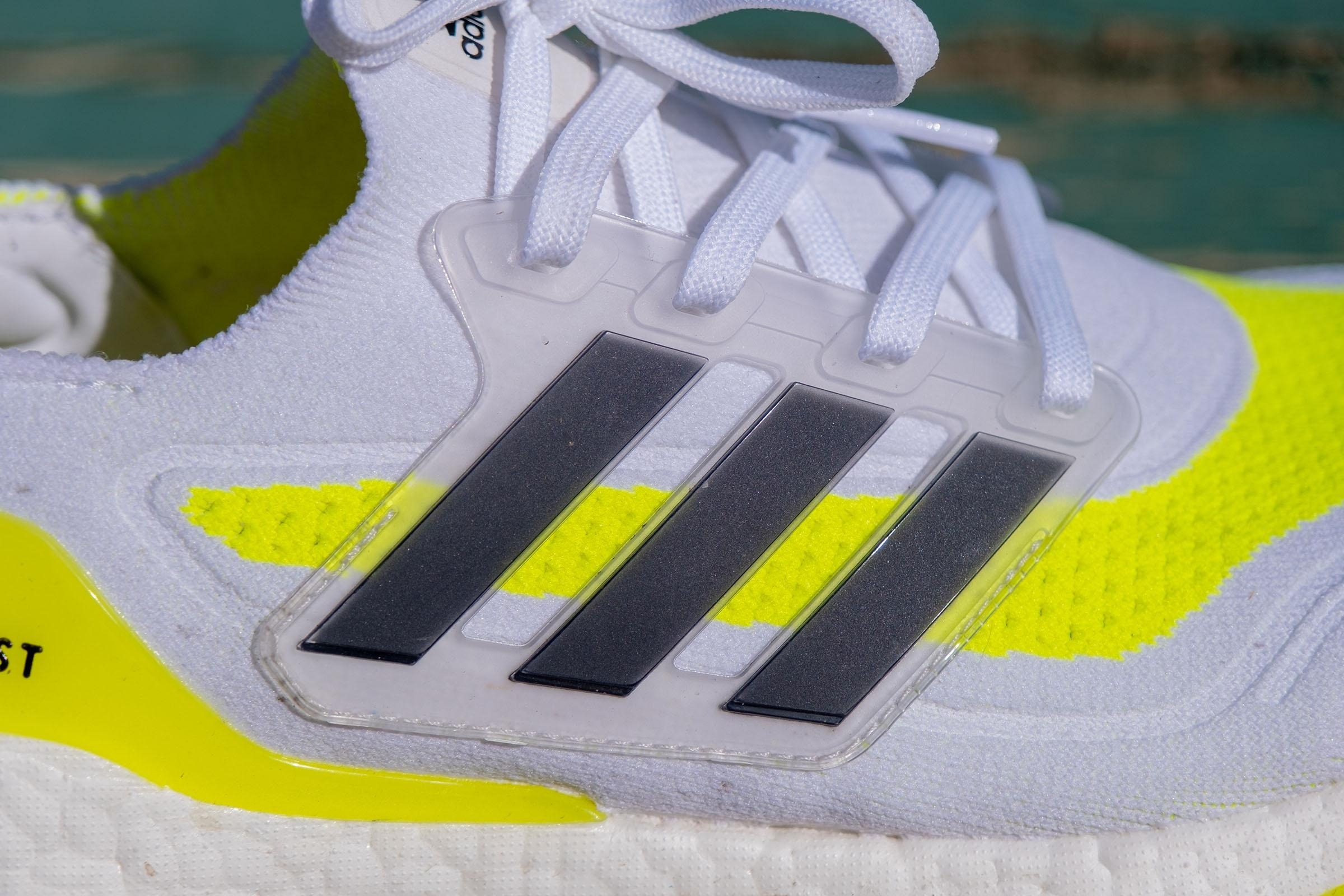
It’s made from fused yarn, which creates an ever-loved sock-like feel.
Weird-looking Adidas midsoles
The most unique-looking Adidas shoes are 4DFWD and Switch FWD.

|
4DFWD midsoles pros |
4DFWD midsoles cons |
|
3d printed, 39% bio-based material, compliment magnet, 30mins to print a pair, can be fine-tuned |
Heavy, usually not for faster paces or longer distances, softness: balanced to firm (not soft) |
Another unique-looking midsole is found in Adidas Switch FWD. Like the 4DFWD midsole, this one is also heavy and good for daily runs only. Faster paces are a no. Additionally, debris gets stuck easily into the holes.

Switch FWD profile, cut in half, and bottom. There’s also non-full-length TPU plate (neon green/yellow) between the midsole and the lasting board that makes the shoe stiffer and more stable
On the plus side, this shoe is very stable and doubles as a great walking shoe.
Switch FWD midsole is softer than it looks
Adidas and Continental: everything about outsoles
Adidas utilizes 2 outsoles: Stretchweb and Continental. The latter is far more popular. When it comes to the grip in running shoes, you usually have to choose between a superb grip and superb durability. This is because softer rubber is stickier but tends to wear faster, while harder rubber is more protective, and more durable, but can be bad in wet weather.
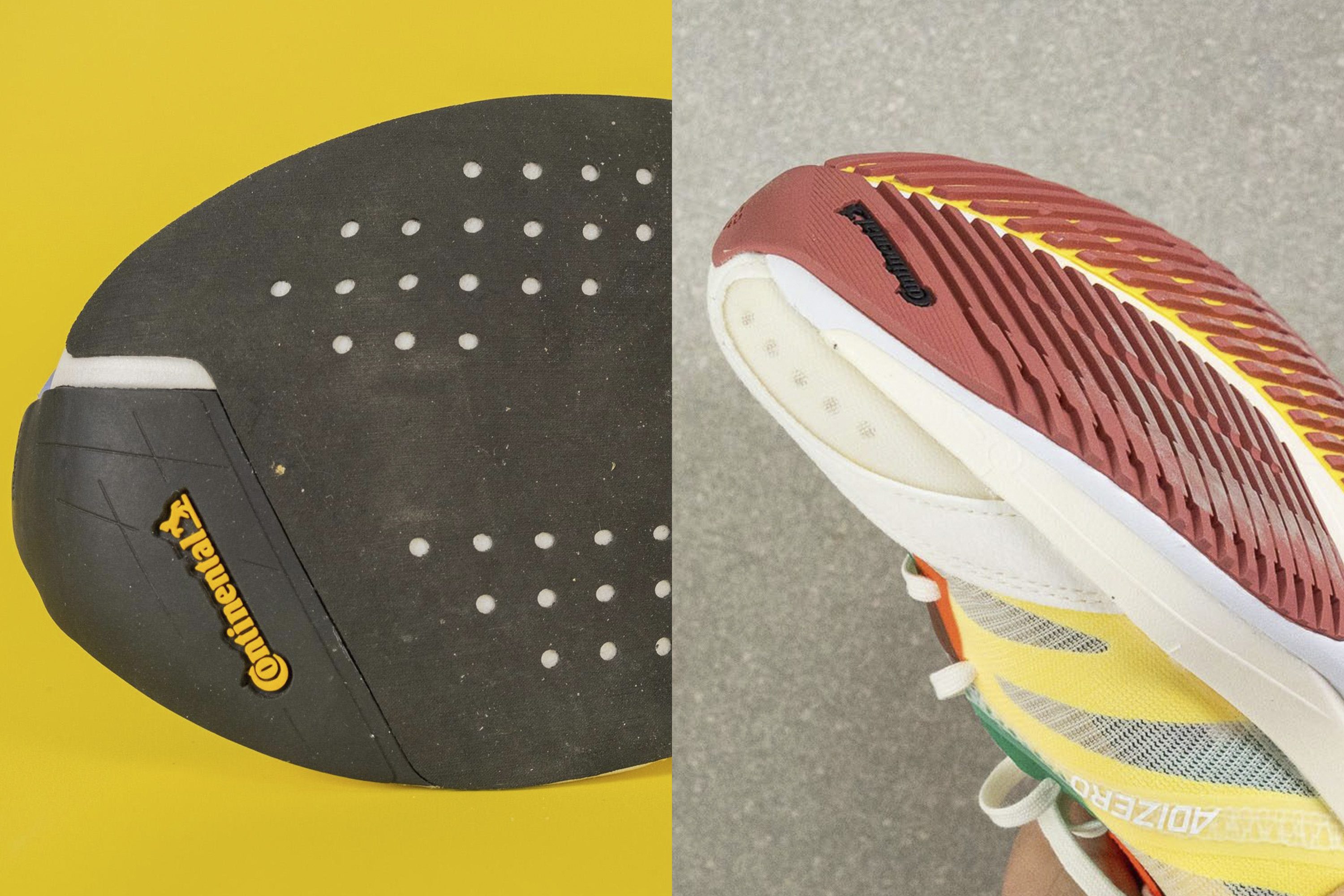
To describe grip in Adidas running shoes better, we will look at the hardness of the outsole, thickness of the outsole, and the durability of the outsole.

We can compare the hardness of the outsole rubber found in Adidas running shoes vs. the overall average outsole hardness. To be able to do this, we measure the hardness of the rubber with a shore C durometer.
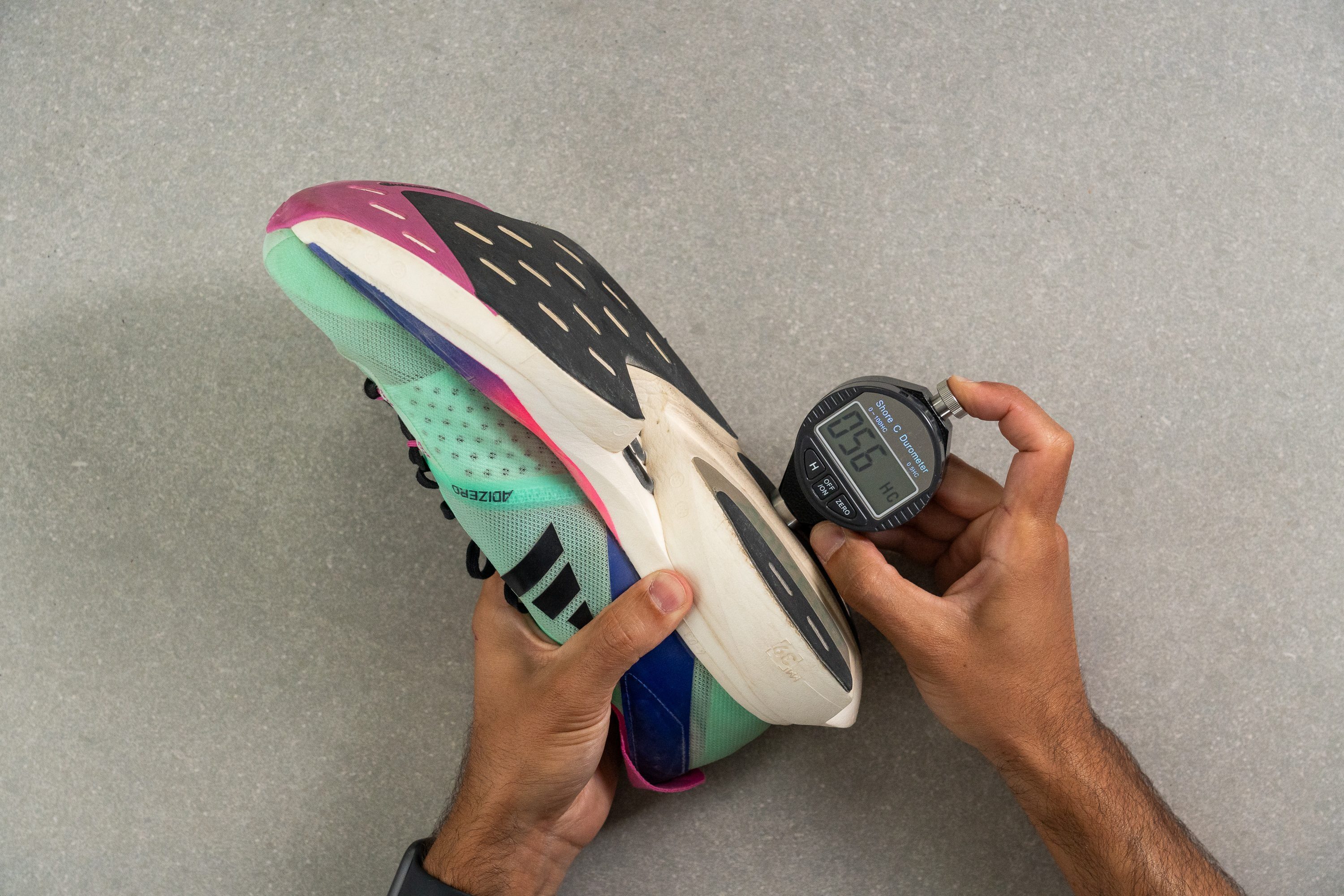
Currently, our lab data shows that the average outsole hardness of Adidas road running shoes is 79.3 while the overall average for running shoes we’ve tested is 80.1. It’s important to note that the harder rubber gives a higher number on the durometer. Vice versa, softer rubbers give lower readings.
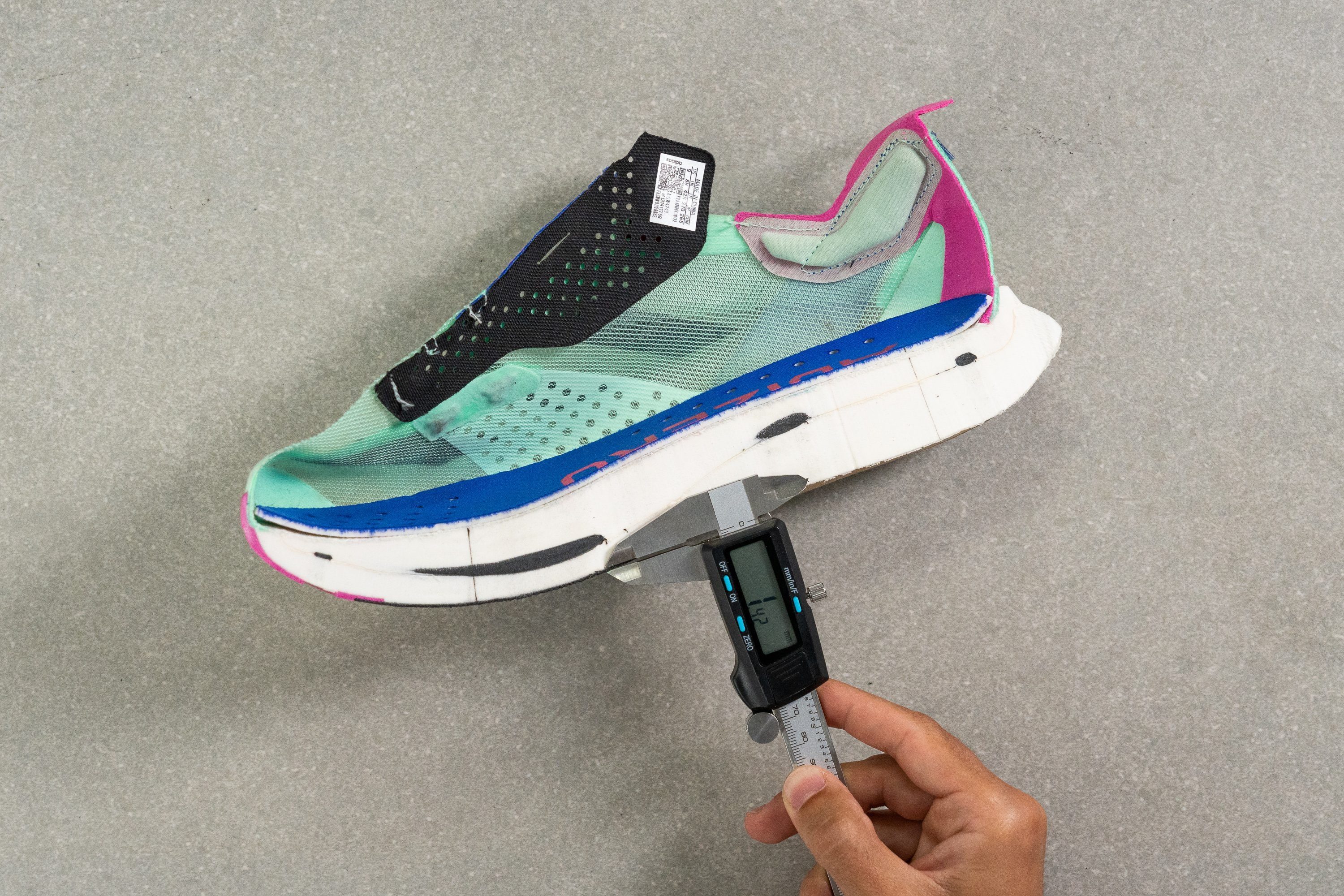
We don’t stop here, so we also measure the thickness of the outsole. The more outsole we have, the more we can damage it, but, it also means that the shoe gets heavier.
The average outsole rubber thickness for Adidas running shoes is 3.0 mm, which is not much different from the overall average, which is 3.2 mm.
And finally, the durability of the outsole. For this test we use a dremel to make the damage on the outsole - we have standardized this test which means we always use the same force, same RPM, and the same duration.
Testing the durability of the outsole
Once done, we measure the dent our dremel has made. We use a tire tread gauge for this. The deeper the dent, the less durable the outsole and vice versa. We have discovered that the average dent depth for Adidas road shoes is 1.2mm, while the average dent depth for all running shoes we’ve tested is 0.9 mm.
Wide toebox in Adidas running shoes
In case you’re worried whether the toebox in an Adidas shoe will fit you, you can look at the measurements of the toebox width. We measure this in 2 places: where it’s the widest and at the big toe. This allows us to understand whether the toebox is pointy (tapers) or not.

Recognizable flap heel tab
Usually found in Adidas Adizero shoes, this flap heel tab has become quite recognizable in Adidas running shoes.
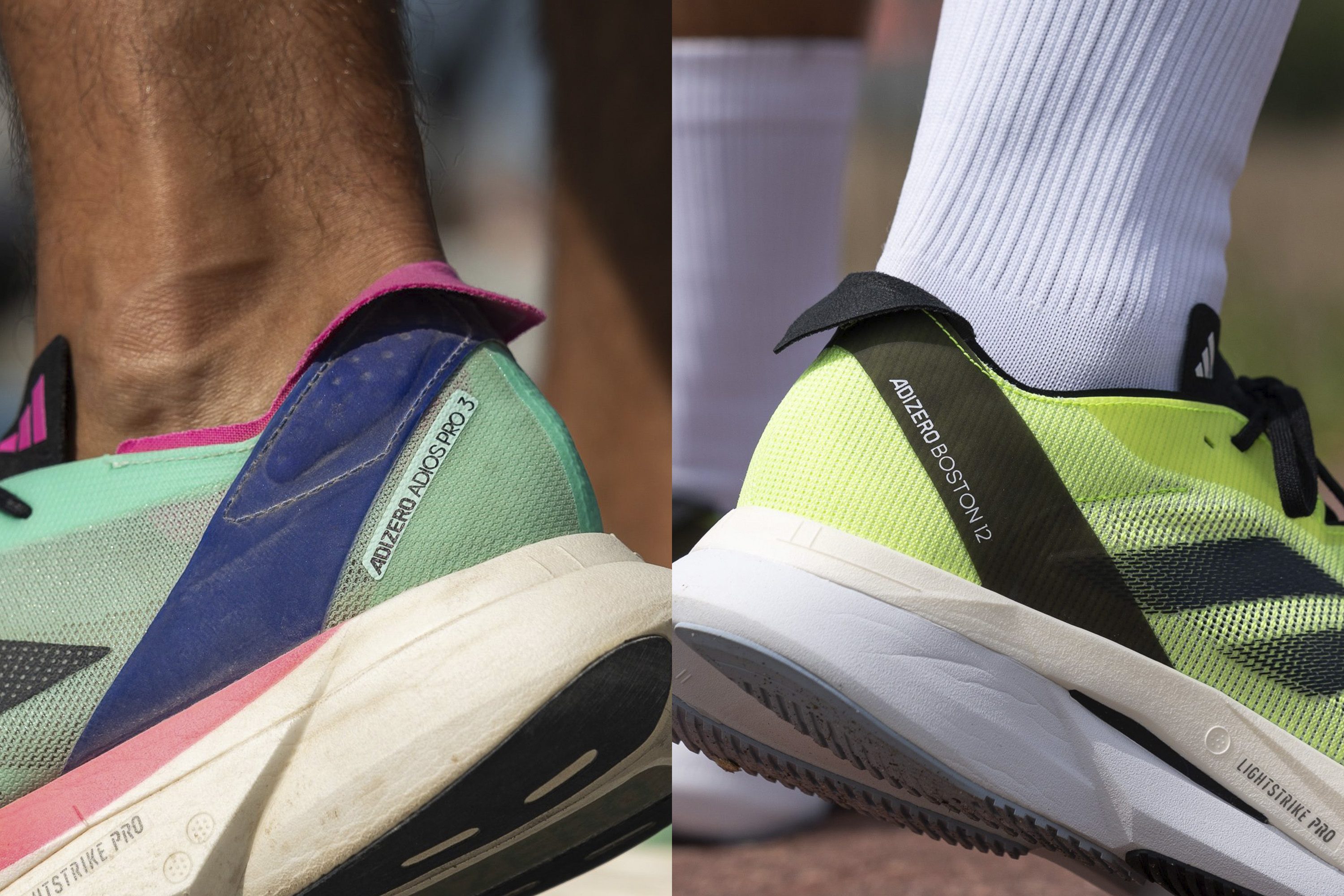
In the image above, we see the flap tab in Boston 12, and Adios Pro 3.
Eco-move: Adidas Parley
Adidas started collaborating with Parley for the Oceans in 2015. This was a big step in the right direction as Adidas, thanks to this initiative, started using polyester yarn made from plastic which was once coastal marine waste.
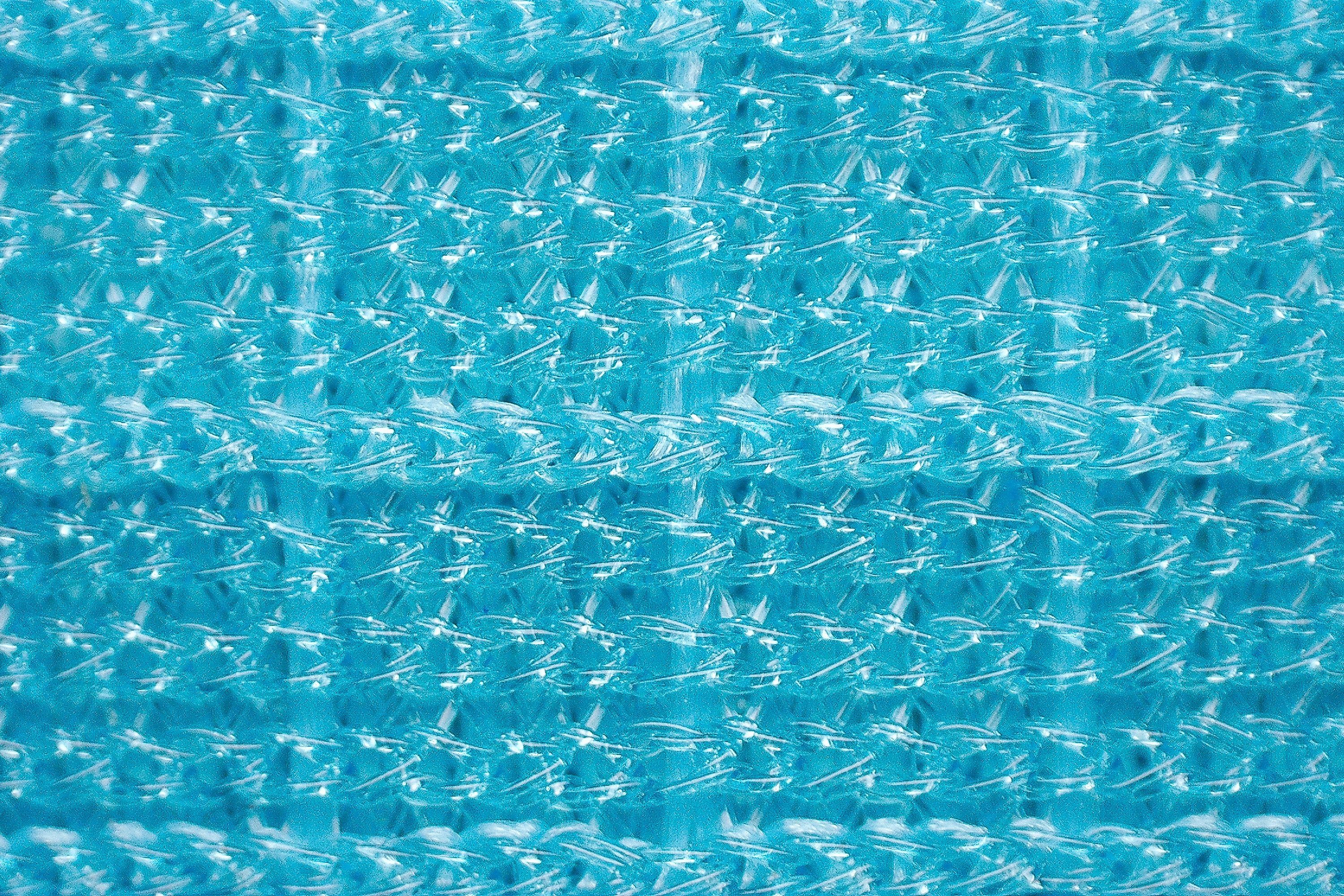
Parley utilizes their network to clean the beaches and collect the plastic and then shred the plastic and rework it to become Parley Ocean Plastic. This is the material that Adidas uses to create x Parley products.
We can often see “Primeblue” in the description of Adidas products and it’s the high performance yarn made with Parley Ocean Plastic.
 Hiring remote: Content writer / review specialist in
Hiring remote: Content writer / review specialist in 
